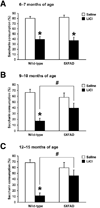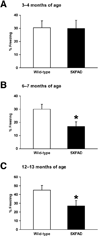Genetic reductions of beta-site amyloid precursor protein-cleaving enzyme 1 and amyloid-beta ameliorate impairment of conditioned taste aversion memory in 5XFAD Alzheimer's disease model mice
- PMID: 20092558
- PMCID: PMC2887274
- DOI: 10.1111/j.1460-9568.2009.07031.x
Genetic reductions of beta-site amyloid precursor protein-cleaving enzyme 1 and amyloid-beta ameliorate impairment of conditioned taste aversion memory in 5XFAD Alzheimer's disease model mice
Abstract
Although transgenic mouse models of Alzheimer's disease (AD) recapitulate amyloid-beta (Abeta)-related pathologies and cognitive impairments, previous studies have mainly evaluated their hippocampus-dependent memory dysfunctions using behavioral tasks such as the water maze and fear conditioning. However, multiple memory systems become impaired in AD as the disease progresses and it is important to test whether other forms of memory are affected in AD models. This study was designed to use conditioned taste aversion (CTA) and contextual fear conditioning paradigms to compare the phenotypes of hippocampus-independent and -dependent memory functions, respectively, in 5XFAD amyloid precursor protein/presenilin-1 transgenic mice that harbor five familial AD mutations. Although both types of memory were significantly impaired in 5XFAD mice, the onset of CTA memory deficits ( approximately 9 months of age) was delayed compared with that of contextual memory deficits ( approximately 6 months of age). Furthermore, 5XFAD mice that were genetically engineered to have reduced levels of beta-site amyloid precursor protein-cleaving enzyme 1 (BACE1) (BACE1(+/-).5XFAD) exhibited improved CTA memory, which was equivalent to the performance of wild-type controls. Importantly, elevated levels of cerebral beta-secretase-cleaved C-terminal fragment (C99) and Abeta peptides in 5XFAD mice were significantly reduced in BACE1(+/-).5XFAD mice. Furthermore, Abeta deposition in the insular cortex and basolateral amygdala, two brain regions that are critically involved in CTA performance, was also reduced in BACE1(+/-).5XFAD compared with 5XFAD mice. Our findings indicate that the CTA paradigm is useful for evaluating a hippocampus-independent form of memory defect in AD model mice, which is sensitive to rescue by partial reductions of the beta-secretase BACE1 and consequently of cerebral Abeta.
Figures






Similar articles
-
Mechanisms that lessen benefits of β-secretase reduction in a mouse model of Alzheimer's disease.Transl Psychiatry. 2013 Jul 23;3(7):e284. doi: 10.1038/tp.2013.59. Transl Psychiatry. 2013. PMID: 23880880 Free PMC article.
-
Partial reduction of BACE1 improves synaptic plasticity, recent and remote memories in Alzheimer's disease transgenic mice.J Neurochem. 2010 Apr;113(1):248-61. doi: 10.1111/j.1471-4159.2010.06608.x. Epub 2010 Jan 20. J Neurochem. 2010. PMID: 20089133 Free PMC article.
-
Effects of BACE1 haploinsufficiency on APP processing and Aβ concentrations in male and female 5XFAD Alzheimer mice at different disease stages.Neuroscience. 2015 Oct 29;307:128-37. doi: 10.1016/j.neuroscience.2015.08.037. Epub 2015 Aug 24. Neuroscience. 2015. PMID: 26314636 Free PMC article.
-
BACE1: the beta-secretase enzyme in Alzheimer's disease.J Mol Neurosci. 2004;23(1-2):105-14. doi: 10.1385/JMN:23:1-2:105. J Mol Neurosci. 2004. PMID: 15126696 Review.
-
Pharmacogenetic features of cathepsin B inhibitors that improve memory deficit and reduce beta-amyloid related to Alzheimer's disease.Biol Chem. 2010 Aug;391(8):861-72. doi: 10.1515/BC.2010.110. Biol Chem. 2010. PMID: 20536395 Free PMC article. Review.
Cited by
-
Increased fragmentation of sleep-wake cycles in the 5XFAD mouse model of Alzheimer's disease.Neuroscience. 2015 Apr 2;290:80-9. doi: 10.1016/j.neuroscience.2015.01.035. Epub 2015 Jan 28. Neuroscience. 2015. PMID: 25637807 Free PMC article.
-
Mechanisms that lessen benefits of β-secretase reduction in a mouse model of Alzheimer's disease.Transl Psychiatry. 2013 Jul 23;3(7):e284. doi: 10.1038/tp.2013.59. Transl Psychiatry. 2013. PMID: 23880880 Free PMC article.
-
5XFAD mice show early-onset gap encoding deficits in the auditory cortex.Neurobiol Aging. 2020 Oct;94:101-110. doi: 10.1016/j.neurobiolaging.2020.05.013. Epub 2020 Jun 1. Neurobiol Aging. 2020. PMID: 32599514 Free PMC article.
-
Synaptic deficits in layer 5 neurons precede overt structural decay in 5xFAD mice.Neuroscience. 2013 Dec 19;254:152-9. doi: 10.1016/j.neuroscience.2013.09.016. Epub 2013 Sep 20. Neuroscience. 2013. PMID: 24055684 Free PMC article.
-
Red Ginseng Attenuates Aβ-Induced Mitochondrial Dysfunction and Aβ-mediated Pathology in an Animal Model of Alzheimer's Disease.Int J Mol Sci. 2019 Jun 21;20(12):3030. doi: 10.3390/ijms20123030. Int J Mol Sci. 2019. PMID: 31234321 Free PMC article.
References
-
- Ashe KH. Learning and memory in transgenic mice modeling Alzheimer's disease. Learn. Mem. 2001;8:301–308. - PubMed
-
- Berger-Sweeney J, McPhie DL, Arters JA, Greenan J, Oster-Granite ML, Neve RL. Impairments in learning and memory accompanied by neurodegeneration in mice transgenic for the carboxyl-terminus of the amyloid precursor protein. Brain Res. Mol. Brain Res. 1999;66:150–162. - PubMed
-
- Bermudez-Rattoni F. Molecular mechanisms of taste-recognition memory. Nat. Rev. Neurosci. 2004;5:209–217. - PubMed
-
- Cai H, Wang Y, McCarthy D, Wen H, Borchelt DR, Price DL, Wong PC. BACE1 is the major β-secretase for generation of Aβ peptides by neurons. Nat. Neurosci. 2001;4:233–234. - PubMed
-
- Carlesimo GA, Oscar-Berman M. Memory deficits in Alzheimer's patients: a comprehensive review. Neuropsychol. Rev. 1992;3:119–169. - PubMed
Publication types
MeSH terms
Substances
Grants and funding
LinkOut - more resources
Full Text Sources
Medical
Molecular Biology Databases

